“I remember the turtle.”
“That turtle was a piece of my childhood.”
If you grew up on the West Side of Chicago in the 1950s and 60s, you’re probably familiar with it. The building, once located at 1551-55 W. Madison in the triangle within Madison, Ashland and Ogden, has gone by many names over the years but what was perhaps more impressive than the building itself was the giant 34 foot turtle that sat atop it.
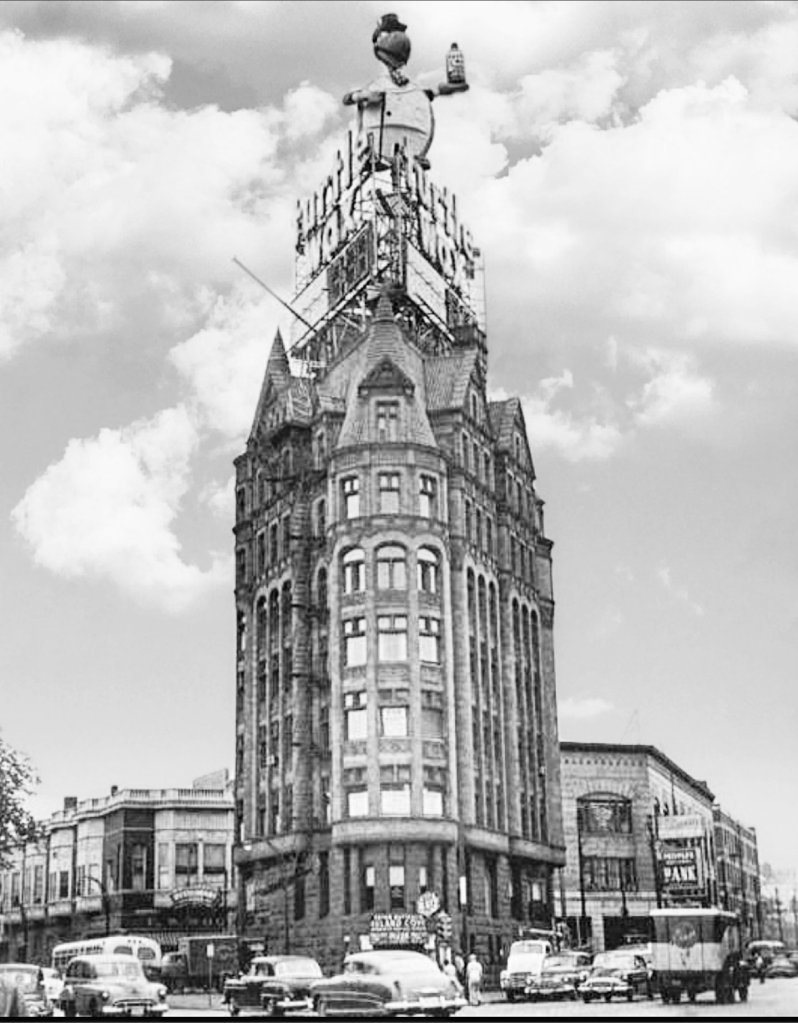
Although it only stood for just over seven years, the turtle — the mascot for the Chicago-based Plastone Turtle Wax company — is engrained in the memories of many Chicagoans.
Robert Zamora remembers it fondly. “My Dad said that, before he started learning English and his way around, he would refer to Madison Street as Tortuga Street!” (“Tortuga” being Spanish for “turtle.”) “The turtle was an apparent point of reference if he would lose his way around there.”
Before the turtle came, its “nest” already had been a landmark building to those who lived in the area. In the late 19th century, the lot itself — located in the middle of the growing West side intersection of Madison, Ashland and Ogden — had been recognized as an attractive property by none other than Cyrus Hall McCormick Jr. (of the prominent McCormick family).
Rumor has it that as soon as the litigation is concluded, which will be soon, Mr. C.H. McCormick will cover the triangular lot bounded by Madison, Ogden, and Ashland, with an attractive structure, made in most part of iron and glass. The intention is to make the design very neat and worthy of the location.
The Inter Ocean, April 4, 1885
It is uncertain if McCormick had anything to do with the final structure that ended up being built there a few years later, but it certainly was attractive.
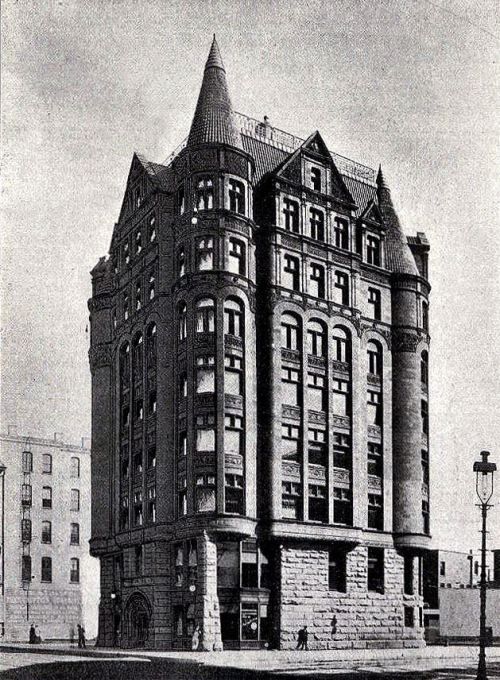
It has been referred to as “the first skyscraper on the West Side” and “the only steel constructed office building on the West Side.” Designed by Albert Smith, the building officially opened on September 1, 1892. It was named the A.J. Stone Building for owner and proprietor A.J. Stone and, upon its opening, he was congratulated for having “changed a neglected triangle which has been an eye-sore to one of the most populous districts of the West Side into an ornament and a monument of beauty.”
Although it was built as an office building, it was used as a hotel to capitalize on the World’s Columbian Exposition that was held in Chicago the following year. It was named the Chicago View Hotel, although it was soon marketed as the Chicago View European Hotel, likely to appeal to a wider clientele.
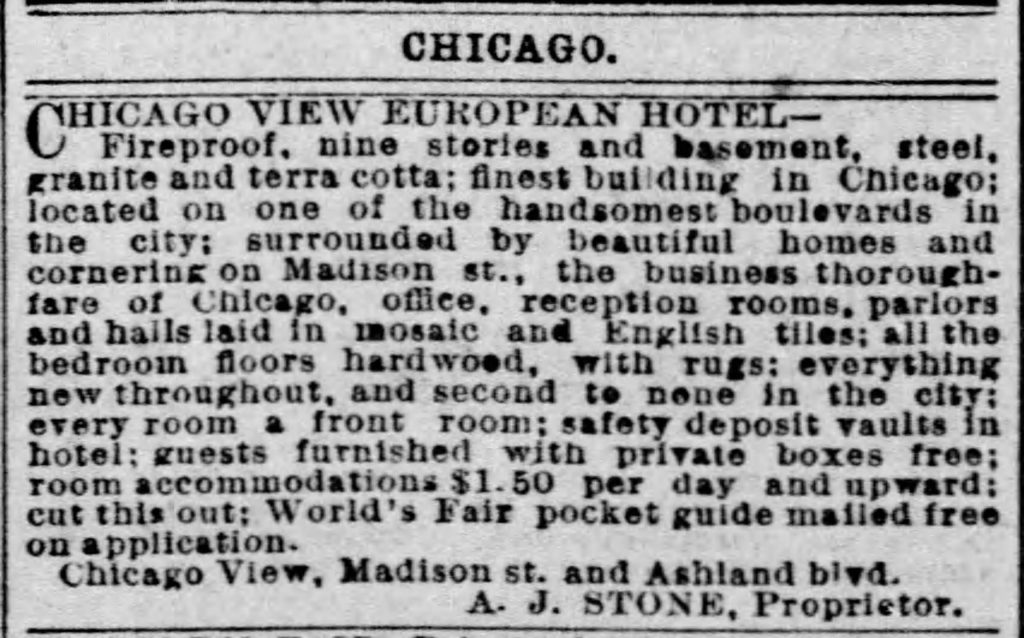
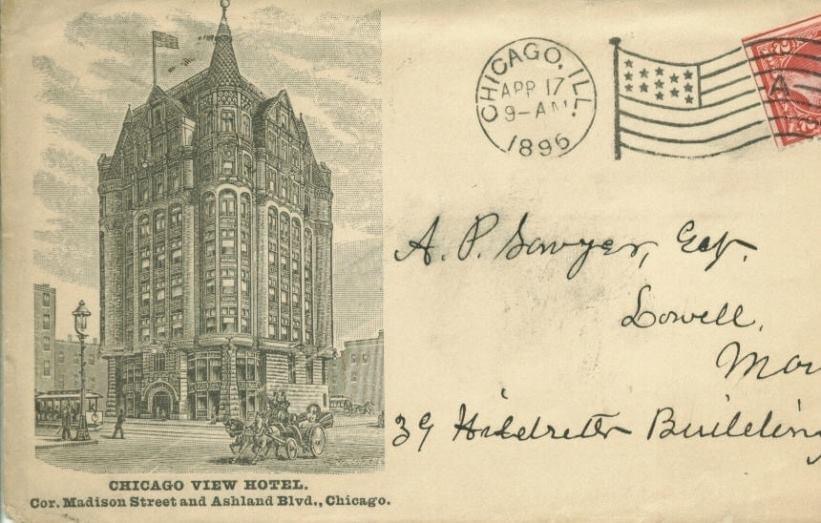
Stone owned a lot of property but was not good with managing his finances, and by Spring of 1896, he lost all of his real estate — including the Chicago View Hotel — into foreclosure. The following year, Northwestern Mutual Life Insurance took over ownership of the building itself.
The Wendell State Bank had been originally located a few blocks southwest at Ogden and Van Buren in the first decade of the 20th century, but once the A. J. Stone Building building was purchased by bank owner Julius A. Wendell and his Wendell Safe Deposit company from Edith Healy Hill, the bank moved into the first floor and the building was rechristened the new Wendell Bank Building.
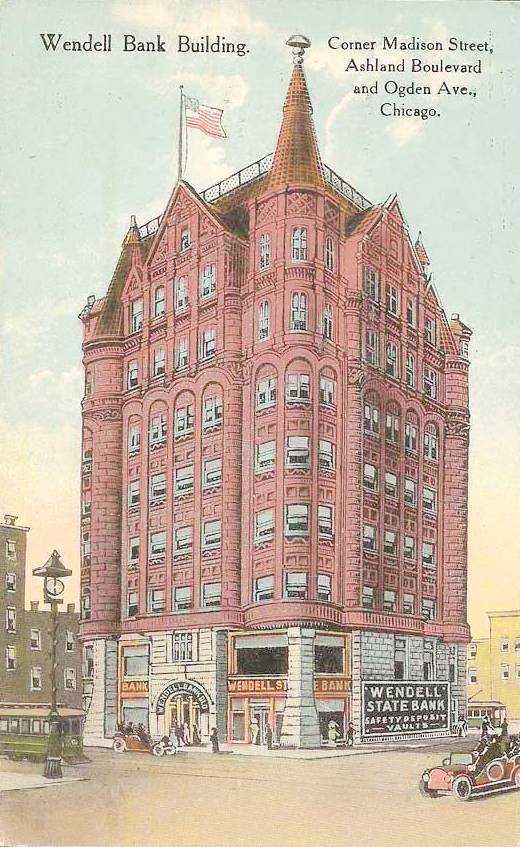
Despite the renaming, Wendell Bank’s time there was limited and, in 1917, Reliance State Bank took over the space, and the building was renamed again to the Reliance State Bank Building. Wendell himself, along with Reliance owner Raymond Cordona, sold their stake in Reliance to the Flatiron Building corporation in 1919. Reliance Bank moved out of the building to the opposite corner in 1921.
It was often simply referred to as the old “Flatiron Building” and the “Triangle Building” in the decades following (not to be confused with the many other flatiron and triangle-shaped buildings in the city), housing offices for physicians and lawyers. Sometime between the 1926 and 1937, the building’s owners sought out a new way to make money on the building by ripping out the scenic rooftop garden and adding scaffolding for valuable advertisements which could catch the eyes of passersby from miles away. This renovation would help secure the building’s legacy in the final years of its existence.
In July 1946, the building underwent its first exterior cleaning in its existence. The Chicago Tribune stated “neighborhood residents, unaccustomed to the structure’s new appearance, said it stands out ‘like a diamond among near-by buildings.’”
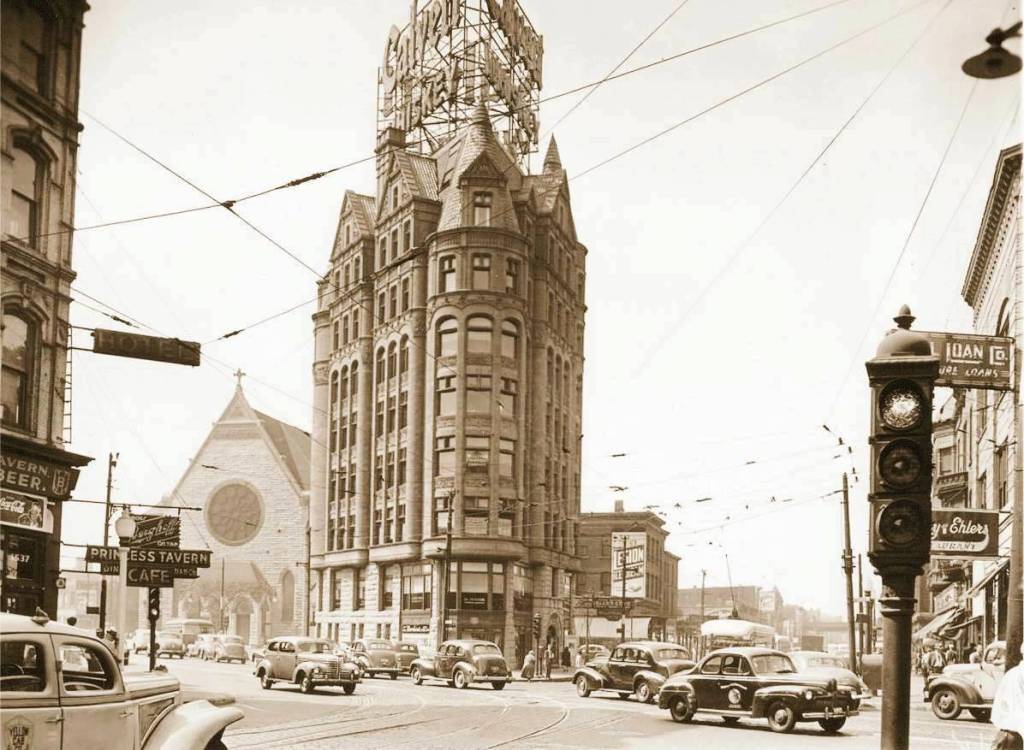
It wasn’t until 1956 that the Chicago-based Plastone Turtle Wax company, led by president Ben Hirsch, came up with a high-profile marketing gimmick to advertise their burgeoning Turtle Wax “Miracle Auto Polish.” Taking a cue from the popular Weather Bell downtown, the company would mount a large-scale model of their popular Tommy the Turtle mascot on a giant three-sided Turtle Wax sign atop the Triangle Building overlooking the West Side.
The sign would show the time and weather forecast. Tommy would rotate and his shell would change colors based on the forecast. The story is that Hirsch was inspired to create the weather turtle from being a native Chicagoan and dealing with constantly-changing weather. A late idea he had was “when weather gets in the way it often does in Chicago,” the big turtle would simply light up huge letters spelling “MISERABLE.”
The statistics on the structure are staggering:
- The turtle was 34 feet (3.5 stories) tall. It was made of 3,200 square feet of fiberglass and 15,000 pounds of steel.
- The three-sided Turtle Wax sign on which it was perched was 7.5 stories tall (keep in mind, the building itself was 10 stories tall).
- The cost was $200,000 (nearly $2 million in 2021 dollars!)
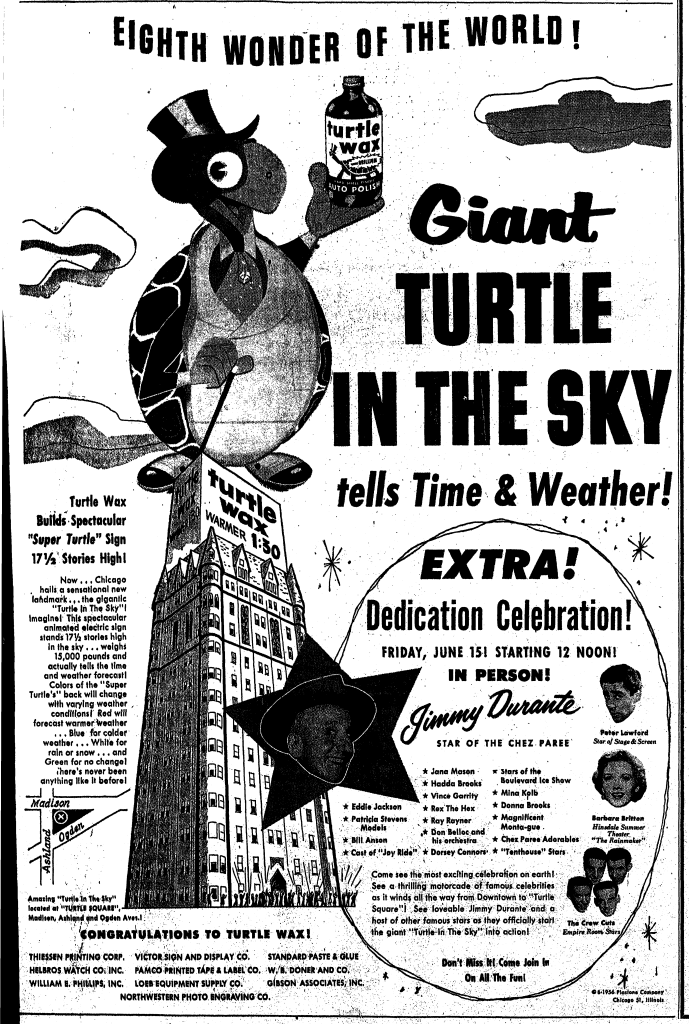
The turtle was mounted in June 1956 and the company held a celebrity-filled parade, that went from downtown to the intersection, which was dubbed “Turtle Square” for the dedication and reveal of the sign. (Sidenote: Why did they name it “Turtle Square” when it was a triangle? Why wouldn’t they go for the alliterative and accurate Turtle Triangle?)
Over the next few years, the turtle was an icon on the West Side. It could be spotted from the new Eisenhower Expressway to the South that had been completed just a year prior, as well as the Lake Street Line on the CTA to the North. I’ve read so many great memories online of this landmark.
“[I] could see him from my parent’s bedroom window [and I w]ould stare at it when I was sick.”
Angela C., Forgotten Chicago Facebook group
“That was my thrill when I was little, to go for a ride to see the turtle.”
Seran W., Forgotten Chicago Facebook group
“My wife rode the El downtown every day and was always angry with the Turtle because the time on the clock was always wrong!”
Jim V., Forgotten Chicago Facebook group
Although he would last in the memories of Chicagoans for decades, unfortunately, the turtle did not last more than seven years overlooking the West Side before he was taken down in October of 1963.
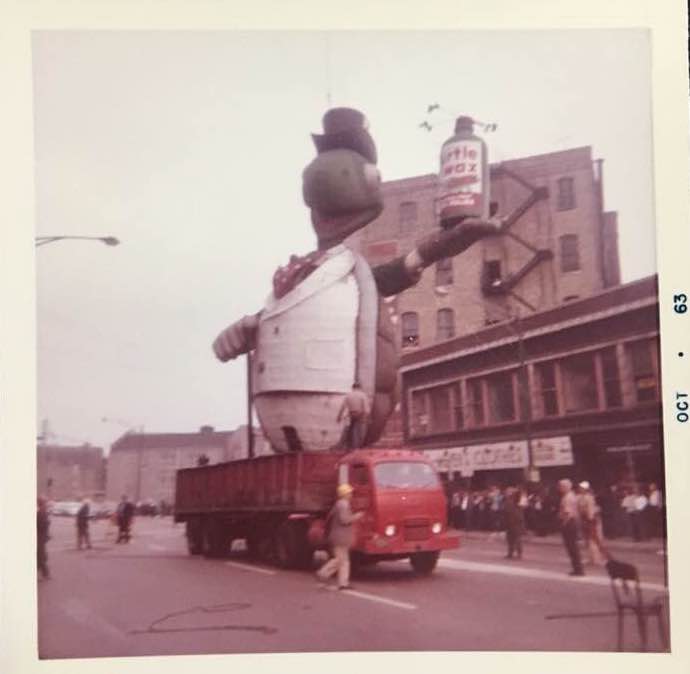
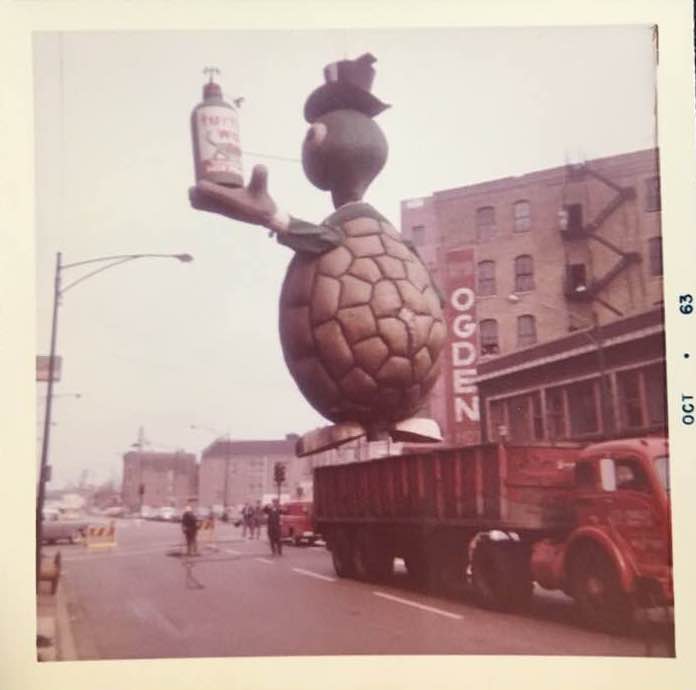
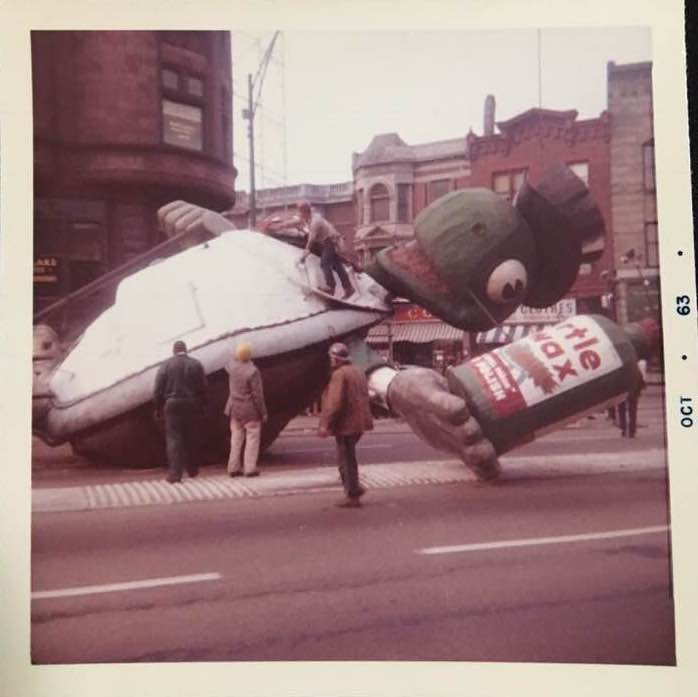
It is unknown if the building’s fate had already been known when the turtle was removed, but building owner Peter Battaglia, who was also the manager of the Island Cove restaurant on the bottom floor of the 61-year-old triangle building, sadly had the building torn down the following year. The neighborhood had changed immensely since its construction in the late 19th century and upkeep for the coal-heated nine-story office building had to be getting expensive. Many of the older buildings in the surrounding area also met their end around the same time. The triangle building was replaced with modest two-story office building in 1965.
According to Albert F. (via Forgotten Chicago on Facebook), who worked for Battaglia, one interesting surviving piece from the 1892 building survived during this time: “[W]hen the original building was torn down, a steel and cement bank vault in the basement from the original high rise building was saved, and incorporated in the two story office building.” The replacement building was a savings and loan, followed by “a medical center, then a video rental store, and finally a package good liquor store.” The 1965 building was eventually torn down in the 1990s.
A 1950s Herbert Ferber abstract expressionist sculpture now sits on the triangle of Ashland, Madison and Ogden.


Clearing the air on the triangle building and the Turtle in the Sky
The giant turtle and it’s building has been talked about a lot online, mainly in the last ten or so years with the rise of Facebook groups and blogging sites. I’ve read a lot of claims on the icon, and I just wanted to clear the air on some items based on my research. (Note: If any of my research can be refuted or updated, feel free to reach out to me!)
Wait, isn’t that building still standing? No, it definitely is not. The building you’re likely thinking of is the similar-looking three-sided building bounded by Madison, Ogden and Monroe which sits across the street from the old triangle building stood. It was interestingly built around the same time (1894) but is considerably shorter.
I heard the Turtle Wax sign was only lit once, and a complaint from Midway Airport tower said it interfered with communications, so it was never lit again. Is this true? I was not able to find any contemporary newspaper articles about the Midway complaint about that during the period which the turtle stood. A functioning turtle (changing colors and rotating) and a functioning clock (albeit not with an accurate time) is definitely in the memories of many Chicagoans and the different photos I’ve seen of the turtle all show it facing different positions.
Weren’t the Turtle Wax headquarters also located in the triangle building at Ashland, Ogden and Madison? A number of blogs and even Geoffrey Baer state that the Turtle Wax headquarters had, at one time, been located inside the triangle building itself. However, I couldn’t actually find any evidence of this. In the 1950s, the company headquarters were at 4100 W. Grand Avenue. and then at 1800 N. Clybourn Avenue in the early 1960s. They definitely were not the building owners at the time and, if they had any offices there, they were unlisted.
Whatever happened to the giant Tommy the Turtle structure once it was removed from the building? There are a few rumors about this, but the fact is: no one really knows for sure.
- Geoffrey Baer stated “the company attempted to move [the turtle] to their new headquarters [if true, assumedly at Clybourn Avenue] but they told us they could not find a way to reconstruct it properly.”
- Another post online states it was “sold to an amusement park.”
- Another post claims Turtle Wax “has it stored in a warehouse in Chicago.”
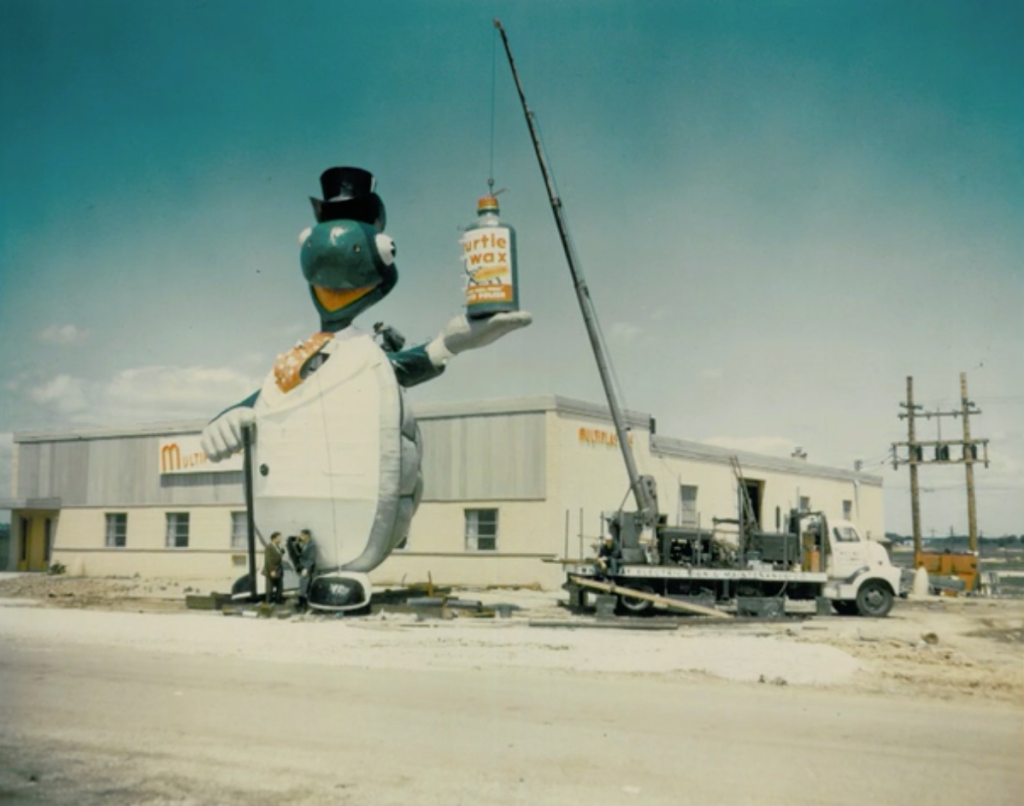
One response to “From World’s Fair to Turtle Square: A Lost Landmark Building on Chicago’s West Side”
My dad drove me and our new 1957 Chevrolet Bel Air past The Turtle and I will never forget it. My dad passed away in 1958 and this memory was especially important to me. Thanks for the history lesson.
LikeLiked by 1 person